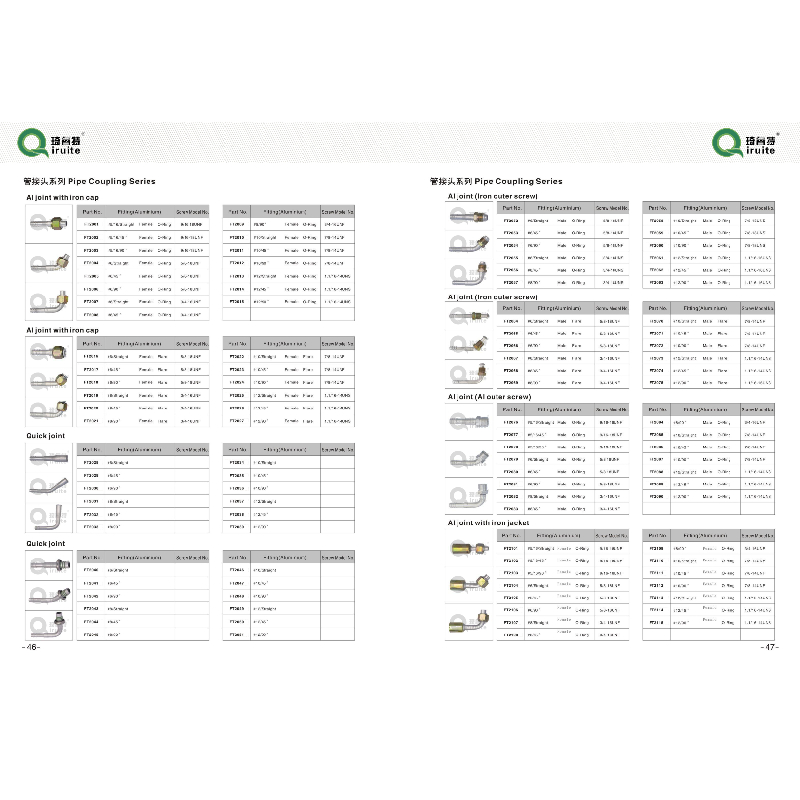Quick Release Ball Joints: Fast, Reliable Connections
Understanding Quick Release Ball Joints in Industrial Applications
In the realm of industrial fluid handling and mechanical systems, efficient and reliable connection solutions are paramount. The quick release ball joint stands out as a critical component, engineered to facilitate rapid assembly, disassembly, and repositioning of pipelines and machinery parts. This technology significantly reduces downtime, enhances operational flexibility, and ensures system integrity in demanding environments. Unlike traditional bolted or welded connections, a quick release ball joint offers unparalleled ease of maintenance and modification, making it indispensable across a spectrum of heavy industries. Its design often incorporates a spherical head that fits into a socket, allowing for angular movement while maintaining a secure, leak-proof seal under pressure. This mechanism is crucial for dynamic systems requiring adaptability, from simple agricultural setups like those using a rainbird coupler to complex petrochemical infrastructures.
The demand for robust and versatile coupling solutions has propelled the quick release mechanism to the forefront of engineering innovation. Industry trends point towards a growing preference for modular and easily reconfigurable systems, driving the adoption of solutions like the ball joint quick disconnect. This shift is influenced by the need for faster project turnovers, reduced labor costs, and improved safety protocols. Manufacturers are continuously refining designs to offer higher pressure ratings, wider temperature tolerances, and enhanced chemical resistance, catering to the increasingly stringent requirements of modern industrial processes. The integration of advanced materials and precision manufacturing techniques has elevated the performance and reliability of these joints, making them a preferred choice for critical applications where system uptime is directly linked to productivity and profitability.
Manufacturing Process and Technical Specifications
The manufacturing of a quick release ball joint involves a sophisticated multi-stage process designed to ensure durability, precision, and reliable performance. Typically, high-grade materials such as stainless steel (e.g., SS304, SS316L), carbon steel, or specialized alloys are selected based on the intended application's corrosive environment, temperature, and pressure requirements. The process often begins with material preparation, followed by primary shaping techniques. For critical components, forging is preferred to achieve superior grain structure and mechanical strength, reducing the likelihood of internal defects. Alternatively, high-precision casting is used for complex geometries, followed by rigorous quality checks to detect porosity or inclusions.
Subsequent steps involve advanced CNC machining to achieve the precise tolerances required for the ball and socket components, ensuring a perfect fit and leak-proof seal. This precision is vital for the smooth operation and longevity of the joint. Surface treatments, such as passivation for stainless steel or protective coatings for carbon steel, are applied to enhance corrosion resistance, extending the product's lifespan significantly, especially in harsh industrial settings. Each quick release ball joint undergoes stringent detection standards, including ISO 9001 for quality management, ANSI B16.5 for flange dimensions (where applicable), and ASTM material specifications. Non-destructive testing (NDT) methods like ultrasonic testing, magnetic particle inspection, or dye penetrant inspection are routinely employed to verify material integrity and weld quality, guaranteeing compliance and safety. The typical design life of these components can range from 10 to 25 years, depending on operating conditions and maintenance schedules.

Below is a table outlining typical technical parameters for a high-performance quick release ball joint:
| Parameter | Typical Range/Value | Notes |
|---|---|---|
| Nominal Diameter (DN) | DN50 - DN600 (2" - 24") | Larger sizes available for custom orders. |
| Working Pressure | PN10 - PN40 (1.0 - 4.0 MPa) | Higher pressure ratings for specialized applications. |
| Operating Temperature | -20°C to +180°C | Depends on seal material and media. |
| Material (Body) | Carbon Steel, Stainless Steel (304, 316L), Duplex Steel | Selection based on media corrosivity and strength. |
| Seal Material | NBR, FKM, PTFE, EPDM | Chosen for chemical compatibility and temperature. |
| Angular Deflection | Up to ±15 degrees | Enables flexibility in pipeline alignment. |
| Connection Type | Flanged, Welded, Grooved | Customizable to existing pipe systems. |
Application Scenarios and Technical Advantages
The versatility of the quick release ball joint makes it indispensable across a multitude of industries. In the petrochemical sector, these joints are crucial for flexible pipeline connections in tank farms, loading/unloading operations, and temporary bypass lines, where their ability to manage thermal expansion and ground movement is paramount. For the metallurgical industry, especially in steel mills and mining, they provide robust connections for cooling water lines or slurry transport, offering resilience against abrasive media and high temperatures. In water supply and drainage systems, from municipal networks to large-scale irrigation (analogous to how a rainbird coupler works on a smaller scale), these joints accommodate ground settlement and seismic activity, preventing pipe stress and leakage.
Beyond these, other key applications include dredging, shipbuilding, power generation, and chemical processing. The primary technical advantages of employing a quick release ball joint are multifaceted. Firstly, their inherent flexibility mitigates pipe stress caused by vibration, ground movement, or thermal expansion, thereby extending the lifespan of the entire piping system. Secondly, their robust design ensures exceptional corrosion resistance, particularly when manufactured from specialized alloys, crucial for handling aggressive fluids. This feature leads to significant energy savings by preventing leaks that would otherwise result in energy loss and costly repairs. The quick disconnect feature also translates into reduced maintenance downtime and operational costs, offering a compelling return on investment for industrial clients.
Manufacturer Comparison and Custom Solutions
When selecting a quick release ball joint supplier, industrial buyers often evaluate several factors, including product quality, certifications, customization capabilities, and after-sales support. While standard quick joints are widely available, reputable manufacturers distinguish themselves through their commitment to engineering excellence and client-specific solutions. For instance, some companies may offer lines comparable to a euclid quick joint or euco quick joint, providing reliable performance for general applications. However, for highly specialized or challenging environments, a deep understanding of material science, stress analysis, and fluid dynamics is critical.
Leading manufacturers not only adhere to international standards like ISO and API but also possess the expertise to provide highly customized solutions. This includes tailoring material grades for extreme temperatures or corrosive media, designing specific pressure ratings, or integrating unique connection types to seamlessly fit existing infrastructure. For example, a client requiring a large-diameter quick release ball joint for a dredging operation might need specific wear-resistant internal coatings or a specialized locking mechanism for ease of underwater deployment. Similarly, for applications needing rapid concrete or slurry delivery, solutions akin to a fast point tub 15kg buff might necessitate specific internal lining and sealing mechanisms to ensure minimal abrasion and extended service life. Engagements with industry leaders often include comprehensive engineering consultations, CAD modeling, and prototype testing, ensuring the final product meets exact operational demands.
Application Cases and Client Testimonials
Our quick release ball joint solutions have been successfully deployed in diverse and challenging environments globally, demonstrating their reliability and performance. In a recent project for a major chemical plant in the Middle East, our customized SS316L ball joints replaced traditional flanged connections on a critical acid transfer line. The client reported a 70% reduction in maintenance time during scheduled pipeline inspections and an immediate elimination of minor leaks that were previously persistent issues. This not only enhanced operational safety but also resulted in an estimated 15% reduction in product loss.
Another notable case involved a large-scale mining operation in Australia, where our heavy-duty quick release ball joint units were integrated into a slurry pipeline system designed to handle highly abrasive materials. The client, who previously struggled with frequent pipe misalignment and rapid wear of conventional couplings (often experiencing issues similar to those seen with generic euclid quick joint 200 or euco quick joint 200 products), praised the angular flexibility and robust sealing capabilities of our joints. The solution not only minimized downtime due to pipe burst prevention but also extended the average operational cycle by over 30%, translating to substantial productivity gains. Our commitment to quality is underscored by our ISO 9001:2015 certification, ensuring every product meets rigorous international standards, providing clients with peace of mind regarding the reliability and safety of their installations.
Trustworthiness: FAQs, Delivery, and Warranty
Frequently Asked Questions (FAQs)
-
Q: What is the typical lead time for a custom quick release ball joint order?
A: Standard orders usually ship within 2-4 weeks. For complex custom designs, lead times can range from 6-10 weeks, depending on material availability and manufacturing complexity. We provide precise timelines upon detailed inquiry. -
Q: Can your quick release ball joint handle abrasive media?
A: Yes, we offer specialized internal linings and material selections, such as hardened steels or ceramic coatings, specifically designed to withstand highly abrasive slurries and particles, ensuring extended service life. -
Q: What kind of warranty do you offer on your products?
A: All our quick release ball joint products come with a standard 12-month warranty from the date of installation or 18 months from the date of shipment, whichever comes first, covering defects in materials and workmanship. Extended warranty options are available. -
Q: Do you provide installation support or technical training?
A: While our products are designed for straightforward installation, we offer comprehensive technical documentation and can arrange for on-site supervision or virtual training for your installation team, ensuring optimal setup and performance.
Delivery and Quality Assurance
We maintain robust supply chain logistics to ensure timely and secure delivery of your quick release ball joint orders globally. Our commitment to on-time delivery is matched by our stringent quality assurance protocols. Every product undergoes multiple inspection points, from raw material verification to final performance testing, before dispatch. Packaging is specifically designed for international shipping, protecting the integrity of the components during transit. Our dedicated customer support team is available 24/7 to address any queries regarding product selection, order status, or post-sales assistance, reinforcing our promise of reliable service and support.
References
- International Organization for Standardization (ISO). ISO 9001:2015 - Quality management systems - Requirements.
- American National Standards Institute (ANSI). ANSI B16.5 - Pipe Flanges and Flanged Fittings.
- American Society for Testing and Materials (ASTM). Various material specifications for metals and alloys.
- Fluid Power Society. Handbook of Hydraulic and Pneumatic Principles.
- National Association of Corrosion Engineers (NACE International). Corrosion control standards and practices.
-
Quick Release Ball Joint – Tool-Free, Durable, Leak-TightNewsNov.13,2025
-
Spiral Guard Hose Protection — Durable, UV-Resistant WrapNewsNov.13,2025
-
SAE J1401 Brake Hose Specifications: Durable, Low ExpansionNewsNov.13,2025
-
SAE J1401 Brake Hose Specifications | DOT-Approved, DurableNewsNov.13,2025
-
Spiral Guard Hose Protection - Abrasion-Resistant, UV-StableNewsNov.10,2025
-
SAE J1401 Brake Hose Specifications | DOT-Certified, DurableNewsNov.10,2025

